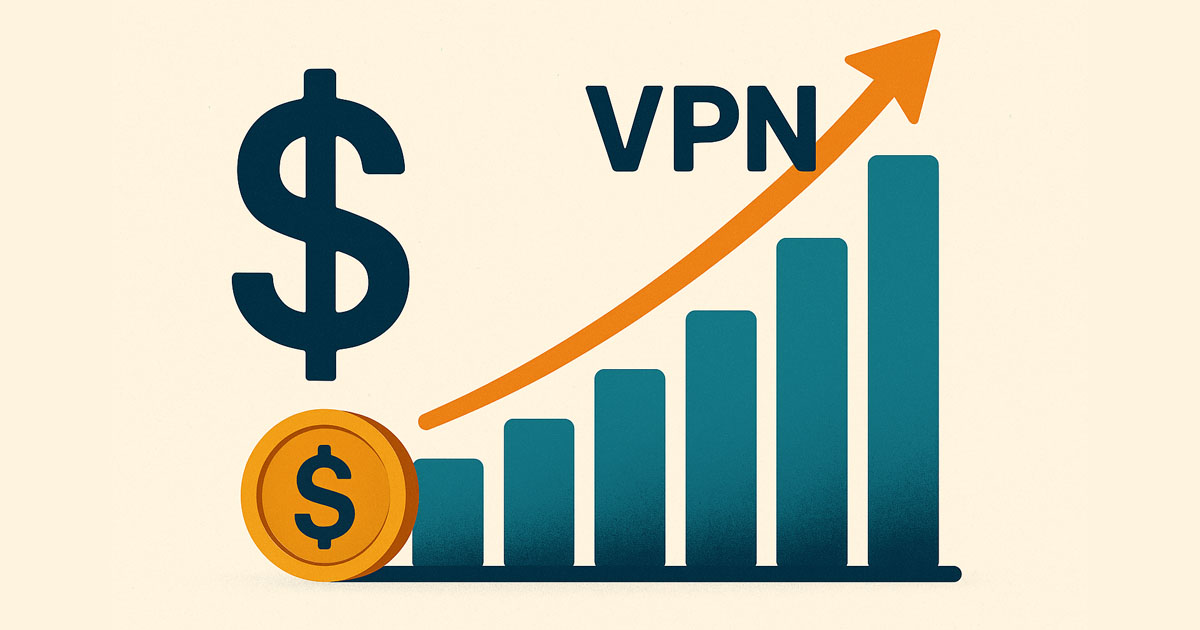The global VPN (Virtual Private Network) market in 2025 is in a phase of accelerated growth. Across various estimates, its size ranges from USD 61 to 78 billion. This expansion is driven by stricter data protection requirements, the shift to hybrid and remote work, and growing user attention to privacy.
Over the past decade, the market has multiplied several times: in 2015, it was roughly USD 15–20 billion; by 2020, it had exceeded USD 30 billion. In 2022, the market reached about USD 41 billion, and by 2025 it doubled and surpassed USD 60 billion. This trajectory reflects rising demand for secure connections, cloud services, and tools for remote work.
Key Market Segments
- Solutions and services: the bulk of the market consists of software products and managed VPN services that are gradually displacing traditional hardware.
- Remote Access VPN: the most in-demand type, especially under hybrid employment and distributed work.
- Cloud VPNs: the fastest-growing segment, providing flexibility and ease of deployment.
- Regional split: North America remains the leader by volume, while the highest growth rates are projected in Asia and emerging regions.
Forecast for the Coming Years
- By 2030: the market may reach USD 120–150 billion with an average annual growth of 15–18%.
- By 2032: some scenarios project growth to USD 230 billion and beyond.
- By 2035: in the most “optimistic” estimates, the market could exceed USD 480 billion.
Main Growth Drivers
- Remote and hybrid work: companies need secure communication channels for employees outside the office.
- Cyber threats: the rise in attacks, data breaches and ransomware forces investment in security.
- Cloud services: migration of applications and infrastructure to the cloud increases demand for secure access.
- Regulatory requirements: personal data protection laws (GDPR and analogues) reinforce the need for VPN usage.
- Device growth: mobile technologies, 5G and IoT make VPN a must‑have protection tool.
- Consumer demand: users rely on VPNs for privacy, anonymity and bypassing geo‑restrictions.
Risk Factors
- Regulatory tightening and potential bans in certain countries.
- Competition from new security architectures — Zero Trust and SASE.
- Technical vulnerabilities and configuration errors.
- Network performance issues and infrastructure quality in developing regions.
- High competition among providers and price pressure.
Development Prospects
- Integrating VPN into broader security systems (Zero Trust, SASE, Endpoint Security).
- Expansion of managed and cloud‑based VPN services.
- Higher requirements for quality and usability, lower latency and higher speeds.
- Emergence of vertical solutions for finance, healthcare, the public sector and education.
- Stronger privacy policies: audits, no‑logs practices, server localization.
- New monetization and subscription models, plus integrations with other security services.
Conclusion: the VPN market continues to grow rapidly and may double or triple over the next 5–10 years. Even under conservative scenarios, the market size by 2030 will exceed USD 120 billion. The main opportunities lie in cloud solutions, managed services and integrating VPN into broader cybersecurity architectures.
Sources:
• Mordor Intelligence — Virtual Private Network Market Size & Forecast 2025–2030
• Coherent Market Insights — VPN Market Forecast 2025–2032
• Future Market Insights — VPN Market Outlook 2025–2035
• The Business Research Company — Global VPN Market Report 2025
• IMARC Group — VPN Market Report 2024–2033
• Grand View Research — Virtual Private Network Market Analysis 2022–2030
• Mordor Intelligence — Virtual Private Network Market Size & Forecast 2025–2030
• Coherent Market Insights — VPN Market Forecast 2025–2032
• Future Market Insights — VPN Market Outlook 2025–2035
• The Business Research Company — Global VPN Market Report 2025
• IMARC Group — VPN Market Report 2024–2033
• Grand View Research — Virtual Private Network Market Analysis 2022–2030






